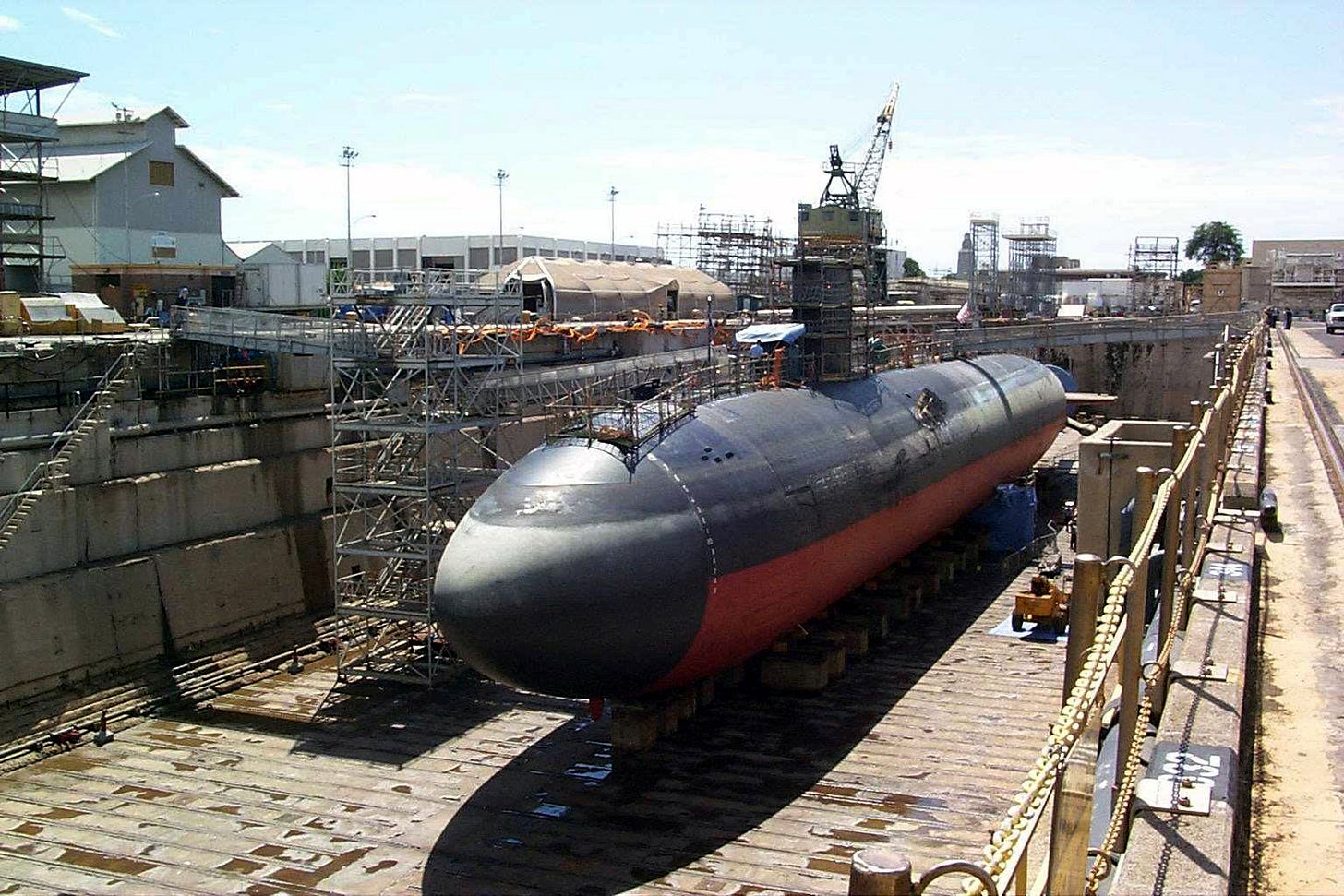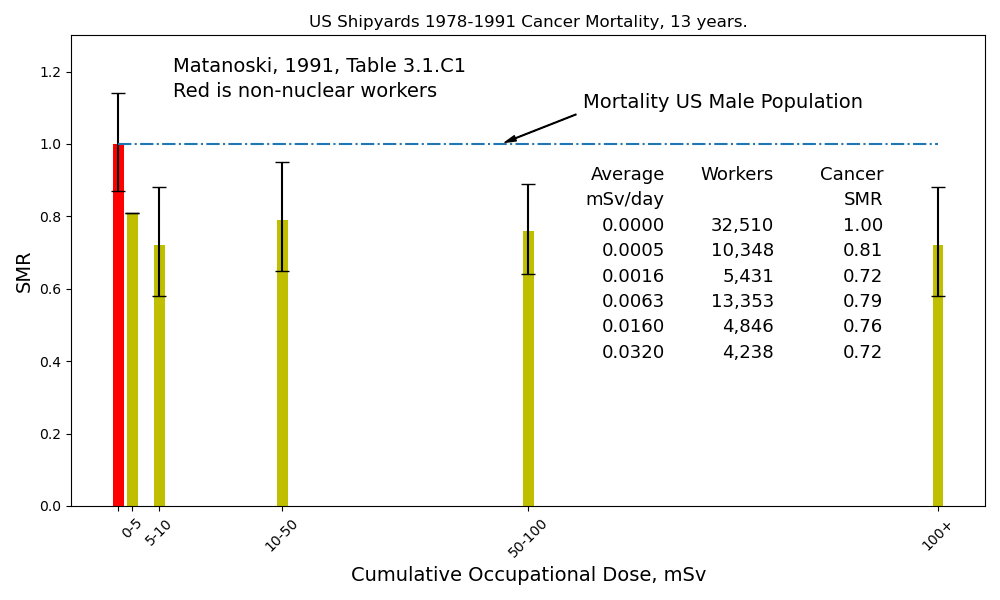Figure 1. Nuclear submarine in dock for overhaul.
Nuclear power history is weird. And one of the weirder nuclear sub-stories is the saga of the US Nuclear Shipyard Workers Study. In 1978, the prestigious medical journal, Lancet, published an article that claimed that workers involved in overhauling nuclear powered subs at the Portsmouth, New Hampshire shipyard had five times higher than normal rates of leukemia.\cite{najarian-1978} The article got lots of horrified press. However, a follow up study on a much larger sample contradicted these results.\cite{rinsky-1981} and Greenberg et al showed that Najarian's puny sample size study was riddled with biases.\cite{greenberg-1985}
But the DOE and the US Navy were suitably alarmed. During operation the steel in the reactor compartment becomes radioactive. The cobalt in the steel absorbs a neutron and becomes Cobalt-60, which emits two high energy photons with a 5.3 year half-life. The reactor plumbing, which does a good job of shielding the workers from leftover fission product radiation, is itself the main concern.
The DOE commissioned Johns Hopkins to do a ten million dollar, 11 year study of a far larger sample of nuclear shipyard workers. The study commenced in 1980 and ended in 1991. Dr. Genevieve Matanoski's team gathered personnel, radiation dosimetry, and industrial hygiene records from eight US shipyards that overhauled nuclear-powered ships from 1957 to 1981. Overall, 799,463 workers were identified of which 604,236 were excluded because they worked less than a year or did not work during a nuclear overhaul period.
In order to work in the nuclear compartment of a US Navy ship, you must have a nuclear badge, usually called a red badge. To get a red badge, you must pass a security check, and a health exam. In the Shipyard Study, the shipyard workers who passed the initial screening were divided into three groups:
1) High Dose Badge. Nuclear badge holders who received a life time dose more than 5 mSv.
2) Low Dose Badge. Nuclear badge holders who received a life time dose less than 5 mSv.
3) No Badge. Non-badge holders.
The badge holders must wear dosimeters whenever they are in a Nuclear Work Area. The dosimetry at all the yards followed rigidly prescribed, standardized Navy procedures.
All 27,872 of the High Dose group were included in the study. They were stratified by shipyard, birth year, hire year, length of employment, and job title (welder, machinist, ...). The job title control is important. It guarantees that the study compared blue collar workers with blue collar workers with approximately the same amount of education. The Shipyard Study avoided the crippling INWORKS error of comparing white collar, desk jockeys with guys who get their hands dirty.
The other two groups were randomly sampled to come up with sub-population numbers that matched the High Dose group categories. Johns Hopkins ended up with of 10,348 Low Dose Badge workers and 32,510 non-badge holders. The Navy Shipyard Workers Study is easily the most carefully controlled, large population radiation study of which I am aware. (Unfortunately, they still made the universal, fundamental error of basing their results on cumulative dose rather than the dose rate profiles.)
The results, Figure 2, were dramatic. Overall, the nuclear workers has a mortality rate 24% below the non-nuclear workers.
Figure 2.Nuclear shipyard workers mortality. SMR is Standardized Mortality Rate, the age and sex adjusted ratio of deaths observed to that of the general population.
The DOE's job is to promote nuclear power. So what did the DOE do? They attempted to bury their ten million dollar study. The study was never officially published. There was not even a peer reviewed article on the study until 10 years later. Under pressure, the DOE issued a press release saying
The results of this study indicate that the risk of death from all causes for radiation-exposed workers was much lower than for US males. These results are consistent with other studies showing that worker populations tend to have lower mortality rates than the general population because workers must be healthy to be hired, and must remain healthy to continue their employment.
This artfully worded deception is reprehensible. It brazenly ignores the fact that their carefully selected control group of fellow workers showed no sign of a healthy worker effect. The SMR for the Non-Nuclear Workers in Figure 2 is 1.00. Their mortality rate was exactly the same as the general male population. Shipyards, especially repair yards, are not a healthy place.
In 1991, nuclear power was already a failed dream. The civilian nuclear side of the DOE had become dependent on interminable clean up programs moving weakly contaminated dirt around, expensive study after study of just how bad radiation is, and the big golden goose, the nuclear waste problem. The study's results did not support these taxpayer ripoffs so the DOE had to make it go away, even if that required making blatantly deceitful pronouncements.
What can we realistically make of the Shipyard Study? It all depends on the control group. If the non-badge holders are the appropriate control group, then the Shipyard Study is a strong argument for a beneficial effect. I worked in two of the yards in the study, Electric Boat and Newport News.1 The red badges were coveted. They meant better job security, more overtime, and a path to further promotions. The yards knew that and used the badges to reward the best workers. These were the guys who showed up on time, and could be counted on to do the job right. These were the people who were more likely to have a stable family life, less likely to have a booze or drug problem. And the security check would weed out some of the latter in case the yard missed it.2
I think a much better control group would be the Low Dose badge holders.3 This would eliminate any selection bias in awarding the red badges. If the Low Dose badge holders is the appropriate control group, then Figure 2 argues for the null hypothesis of no detectable effect. Low dose rate radiation is such a weak carcinogen, that even in as carefully designed study as this, the effects of radiation are overwhelmed by rather ordinary, intra-blue collar, life style differences.
Either way, the Shipyard Study strongly contradicts the whole idea that near background dose rate profiles are something we should worry about, let alone mess up the whole planet to avoid. That's why the DOE tried to bury it.
Either way the Shipyard Study is by far the best designed, best implemented, and best documented nuclear workers study, with easily the highest quality, most standardized dosimetry. Ever since the RERF has admitted that their atomic bomb survivor data is clearly non-linear, the INWORKS study of nuclear workers has become the main weapon for the defenders of LNT. INWORKS claims to be very selective in its choice of worker studies, In their own words,
INWORKS was not intended to assemble the largest number of nuclear workers possible, but rather to assemble those cohorts that were most informative with regard to quality and completeness of exposure and follow up data.\cite{richardson-2015}[p 5]
It's telling that INWORKS does not include the best such study in its assemblage, and does so without even telling us why. In my view, this inexplicable omission alone should remove INWORKS from serious consideration. Only a desperate propagandist would attempt such a ploy.
This was before both yards were taken over by conglomerates, who had perfected the business of buying politicians. When General Dynamics scooped up Electric Boat, one of their first moves was to attempt to bribe/blackmail Rickover by giving his wife expensive jewelry. At Newport News' main gate, there was a statue of the founder Collis Huntington. The inscription on the pedestal was a quote "We will build good ships here; at a profit if we can, at a loss if we must, but always good ships." When Tenneco took over Newport News, the first thing they did was move that statue to a back lot.
The entry medical exam and periodic cancer exams for the badge holders also represent possible biases
Even if we accept my suggestion, we still see a slight drop in all cause mortality with an increase in dose. But a large part of that clearly statistically insignificant decrease could be explained by the fact that these dose rates are so low that, in order to acquire the higher doses, you need to survive longer.




Another great exposure of biased manipulation of public awareness..♡
Hi Jack: Is the Cameron study an update of the Matanoski, or official version of it?